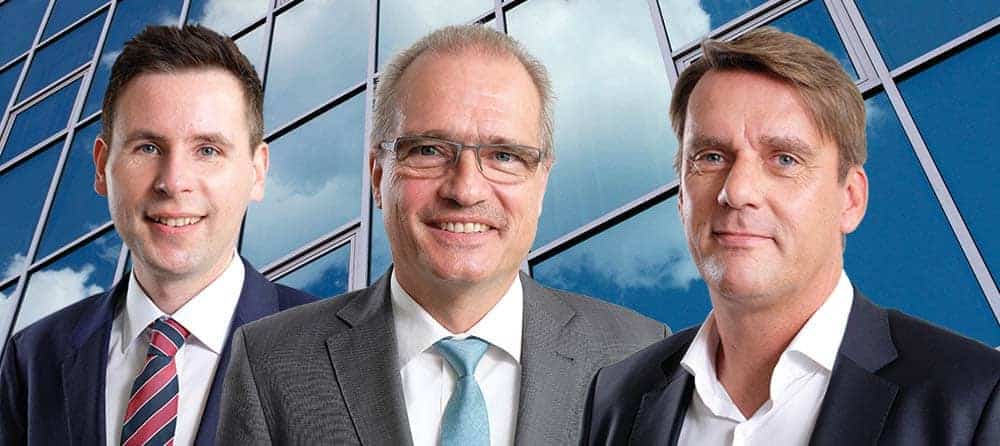Foundation and support for Hana, S/4 and IoT


Digital transformation topics such as Hana, S/4 and IoT need a stable and strategic framework. SAP's framework for this digital transformation is based on open source and, where possible, cloud computing.
E-3 Magazine spoke about this new architecture with Meik Brand, Business Development Manager S/4 Hana, SAP CP, IoT, Big Data and SAP Alliance Manager at QSC, Michael Jores, Regional Director Central Europe at Suse Linux and Michael Schulz, Head of Sales Central Europe Fujitsu.
"Basically, open source enables the provision of open standards. Especially when it comes to the management of hybrid cloud and multi-cloud approaches, these open standards make it possible to implement cloud deployment scenarios".
Michael Jores from Suse Linux describes the comprehensive importance of open source in the SAP community right at the beginning of the interview - that was not always the case.
And Jores logically adds:
"OpenStack for IaaS and Cloudfoundry as PaaS from the OpenSource community are available here as technology and enable precisely this standardization, which is necessary for hybrid cloud approaches and thus for the S/4 application level. This ideally underpins the digital transformation and thus the digitization of processes."
Core Data Services
Jens-Gero Boehm, Suse Linux Director Partner Sales Central Europe and colleague of Michael Jores, complements and defines the operational approach:
"The transformation from ERP/ECC 6.0 to S/4 changes the shares of logic in the application and database, keyword: Core Data Services. In addition, business processes are being remodeled and digitized.
This results in new weightings for the core processes, individual and standard parts of the application. This results in a new devops model for application development, which also leads to a new data center deployment model.
More agility and simplifying data center management at the same time seem like a contradiction at first, but can be well resolved with OpenSource."

Linux initially represents a standardization of the operating system platform for SAP's existing customers.
"OpenStack is used to automate this infrastructure, and Cloudfoundry can be used to develop IoT applications with microservices, for example"
Michael Jores describes the current strategy.
"For the development and operation of SAP core processes, it makes absolute sense to build up in-house expertise and on-premise data centers; the rest of the SAP landscape can be covered by SAP partners and external data centers."
The change as an opportunity
"As Fujitsu, we have experienced that a change is a unique opportunity for all our customers and those who want to become one. At the same time, the change is a unique opportunity to question our own processes.
And in the migration, only those dynamic processes that will actually be needed in the future environment will be included - always with a view to what can actually be implemented in S/4".
Michael Schulz, Head of Sales Central Europe Fujitsu, praises the new options and possibilities for existing SAP customers.
And Fujitsu, like SAP, has a Linux history and a broad commitment to open source:
"We have been relying on open source and on standards since 2003 especially in the SAP environment"
knows Michael Schulz.
"Back then, we worked with Suse and NetApp to develop a forerunner of the Computing Adaptive Controller, which today forms the basis for our operating environment in the SAP environment - namely Flexframe. It stands for flexibility and agility in this environment.
For us, the standards are decisive for the development of these systems. Because a proprietary environment doesn't have the dynamics in further development for a long time as we see in the open source models."
Open source and Suse Linux have become an integral part of the SAP community.
"As open source pioneers of an enterprise Linux for the SAP market, it is important for us to have a technological, close cooperation with SAP and to ensure the support of these same technology platforms in such a way that the operational stability of the SAP data center is guaranteed at all times."
emphasizes Jens-Gero Boehm. And Michael Jores knows that the open source success story will continue:
"The topics of Linux, OpenStack and Cloudfoundry are set. In Software Defined Storage, interesting technological developments are emerging at the moment with CePH to realize cost savings with a Software Defined Storage approach and also to modernize storage approaches."
"To realize the added value of digitization for the company, we need a digital business model. This is supported by digital business processes from S/4".
Jores explains the current strategy. These business processes need the relevant data from sensors, personnel planning, etc. at the right time in order to be able to process them in the process.
SAP Frameworks for Digital Transformation
Analytical capabilities are needed to analyze and adjust the business model, and these are combined on the SAP Leonardo platform. "This means that SAP provides appropriate frameworks and technologies for each step of the SAP customer's digital transformation"
knows Jores as a partner of SAP. His colleague Boehm adds and points out further aspects:
"Starting from the business model of business administration, the business processes are derived, which in turn define the organization. The organization determines the core processes and the necessary peripheral processes.
Companies generally keep core processes on-premise, while peripheral processes can also be shifted to public cloud environments. In the course of this, security becomes a discipline that must in any case be accompanied by necessary seriousness during the project, since both the compliance requirements of the company must be secured and a hybrid cloud operation will also pose this requirement."
Michael Schulz, Head of Sales Central Europe Fujitsu, is aware of the major challenges facing users:
"In an IoT project, many attempts are made for the sake of attempts. We see very clearly in the foreground: to focus on business management.
For the large midmarket customers in Germany, process optimization, the optimization of their own continuous processes is the main driver for IoT projects - always against the background of the connection to existing SAP systems.
And this is where we see the absolute focus. We ourselves have founded an IoT competence center based in Munich; are ourselves one of the largest producers with a plant in Augsburg. And know very well the importance of IoT in production and manufacturing."
And Meik Brand from QSC adds:
"IoT means networking and thus every IoT project has per-se characteristics of a cloud project. The focus changes over time; initially, the focus is often on organization, then integration, and later on scaling and operational reliability."
And Brand also explains that IT security, on the other hand, must be considered in the entire process, i.e., from the very beginning; only considering it later often becomes disproportionately expensive.
IoT needs comprehensive platforms
Given the wide range of requirements for IoT, a platform approach is naturally obvious.
"The term platform is very comprehensive in IoT and Industrie 4.0, as infrastructure and application come together here, and thus functional as well as operational aspects"
knows Meik Brand.
Therefore, no single solution has yet prevailed as a "one fits all". For the selection decision, a requirements profile should be developed that is as clear as possible, against which possible solutions can then be mirrored.
"Whenever process integration or even powerful analytics are required, Leonardo and S/4 are a good choice; if so-called new territory is to be opened up via the application, it is often worth examining the corresponding special solutions."
says Meik Brand.
A similar approach is also shown by Michael Jores from Suse Linux in the E-3 interview:
"The analysis of the business model and the possible disruption of it should be the starting point. If the optimization or conversion of the business model results from this and the digitization of the processes brings added value, then it will be worthwhile going deeper into the digital transformation with IoT.
SAP Leonardo exists as a platform to initiate this process, e.g., with design thinking. Leonardo offers a digital innovation platform based on the SAP Cloud Platform to connect the new technologies around IoT, machine learning, blockchain, analytics, artificial intelligence and Big Data, thus creating a system for digital innovation. To bring out the customer value, SAP relies on the design thinking paradigm."
Design Thinking - what is feasible?
Michael Schulz also supports the idea of using design thinking to quickly achieve insights and results:
"It is important to quickly build up competencies and experience, i.e. a quick learning effect. The focus should be on the use case (which goals are to be achieved) and on a quick demonstration of technical feasibility, a proof of concept.
Experience shows that further ideas emerge with the first show cases - so don't spend too long working on the optimal concept, but start pragmatically."
There is a lot to do: What is striking when talking to the experts is the variety of topics that arise from open source and cloud first and then from Hana, S/4 as well as IoT.
"Customers should not see the change to S/4 purely as a technical upgrade with process improvements, but rather also include the topics such as change management and also the topic of personnel development in the transformation process at an early stage in order to address the following issues."
says Michael Jores from Suse Linux, for example.
Machine communication
Meik Brand from QSC points out that following the networking of human-human communication - social media - machine communication has now inevitably taken off.
"IoT is not a feature but a working foundation and those who do not embrace this trend are massively threatened. Technology today is solvable and evolving rapidly - a positive attitude, two-speed IT and concrete pilots belong on every agenda."
Brand knows from professional practice. Finally, Michael Jores has a few very good tips:
"With open source, customers should pay particular attention to modern technologies such as Hadoop for storing large volumes of unstructured data. SAP has developed a key technology here to enable connectivity. Vora is SAP's in-memory query engine for Apache Spark and Hadoop."







